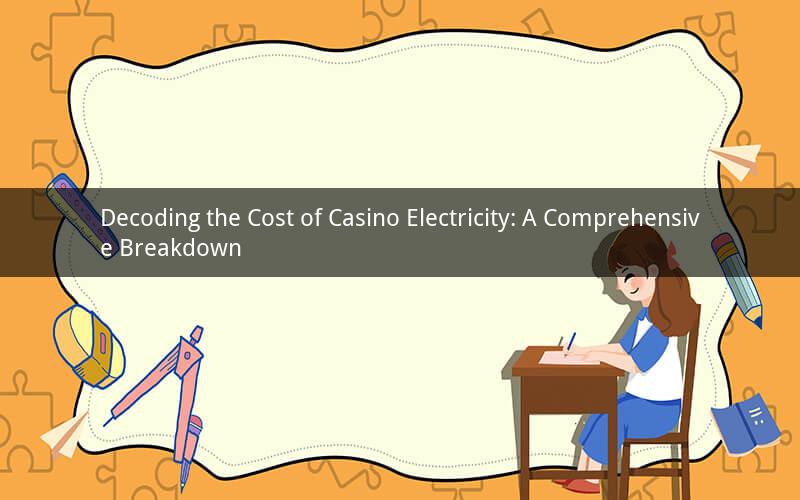
Introduction:
Electricity is an indispensable component in the operation of casinos, providing power for lights, gaming machines, cooling systems, and countless other amenities. The cost of electricity, therefore, plays a significant role in determining the overall expenses and profitability of a casino. This article aims to delve into the factors that influence the electricity bill of a casino and provide an estimation of how much a typical casino might expect to pay for electricity.
I. Factors Influencing Casino Electricity Costs
1. Size and Location of the Casino:
The size of a casino is a major determinant of its electricity consumption. Larger casinos, with more gaming machines, lighting, and other amenities, tend to consume more electricity. Additionally, the geographical location of a casino can affect its electricity costs. Casinos in regions with high electricity rates or fluctuating energy prices will experience higher bills compared to those in areas with lower rates or stable prices.
2. Equipment and Machines:
The type of equipment and machines used in a casino also plays a crucial role in determining electricity costs. Modern gaming machines, slot machines, and other equipment require a significant amount of power to operate, contributing to the overall electricity consumption. Additionally, casinos with advanced lighting systems, heating, and cooling systems will consume more electricity.
3. Operating Hours:
The length of time a casino is operational affects its electricity consumption and, consequently, its electricity bill. Casinos that operate 24/7 will have higher electricity costs compared to those with limited operating hours.
4. Energy Efficiency:
Energy-efficient practices and technologies can significantly reduce a casino's electricity consumption and, subsequently, its electricity costs. Casinos that implement energy-saving measures, such as LED lighting, smart cooling systems, and energy-efficient appliances, will experience lower electricity bills.
II. Estimating the Cost of Casino Electricity
The cost of electricity for a casino can vary widely depending on the factors mentioned above. However, we can provide a rough estimate based on some assumptions.
Assumptions:
- The casino is located in the United States.
- The casino operates 24/7.
- The casino has a size of 100,000 square feet.
- The casino utilizes energy-efficient equipment and lighting.
Based on these assumptions, here's a breakdown of the electricity costs for a casino:
1. Lighting: 40%
Assuming the casino uses LED lighting, it can expect to consume approximately 1 kilowatt-hour (kWh) of electricity per square foot per year. Therefore, the lighting costs for the casino would be:
100,000 sq ft x 1 kWh/sq ft/year = 100,000 kWh/year
At an average electricity rate of $0.12 per kWh, the lighting costs would be:
100,000 kWh/year x $0.12/kWh = $12,000/year
2. Gaming Machines: 30%
Assuming the casino has 2,000 gaming machines, and each machine consumes 500 watts (W) of power, the gaming machines' electricity consumption would be:
2,000 machines x 500 W/machine = 1,000,000 W
Converting watts to kilowatts (kW):
1,000,000 W / 1,000 = 1,000 kW
At an average electricity rate of $0.12 per kWh, the gaming machines' electricity costs would be:
1,000 kW x 24 hours/day x 365 days/year x $0.12/kWh = $1,017,440/year
3. Cooling and Heating Systems: 20%
Assuming the casino consumes 0.5 kWh of electricity per square foot per year for cooling and heating, the costs for these systems would be:
100,000 sq ft x 0.5 kWh/sq ft/year = 50,000 kWh/year
At an average electricity rate of $0.12 per kWh, the cooling and heating costs would be:
50,000 kWh/year x $0.12/kWh = $6,000/year
4. Other Amenities: 10%
The remaining 10% of electricity consumption can be attributed to other amenities such as elevators, security systems, and staff offices. At an average electricity rate of $0.12 per kWh, the other amenities' electricity costs would be:
10% x $12,000/year = $1,200/year
Total Electricity Costs:
$12,000 (lighting) + $1,017,440 (gaming machines) + $6,000 (cooling and heating) + $1,200 (other amenities) = $1,037,740/year
III. Questions and Answers
Q1: How can a casino reduce its electricity consumption and, consequently, its electricity costs?
A1: A casino can reduce its electricity consumption by implementing energy-efficient practices such as using LED lighting, upgrading to energy-efficient gaming machines, and installing smart cooling systems. Additionally, optimizing the operating hours of equipment and machines can help reduce unnecessary energy usage.
Q2: What is the impact of the geographical location on a casino's electricity costs?
A2: The geographical location can significantly affect a casino's electricity costs. Casinos in regions with high electricity rates or fluctuating energy prices will experience higher bills compared to those in areas with lower rates or stable prices.
Q3: Can renewable energy sources be utilized to reduce a casino's electricity costs?
A3: Yes, casinos can utilize renewable energy sources such as solar panels and wind turbines to reduce their electricity costs. By generating a portion of their electricity from renewable sources, casinos can lower their reliance on traditional electricity providers and decrease their overall electricity costs.
Q4: How can a casino measure its energy consumption and identify areas for improvement?
A4: A casino can measure its energy consumption by installing energy meters and tracking the electricity usage of various equipment and systems. By analyzing this data, a casino can identify areas where energy consumption is high and implement improvements to reduce costs.
Q5: What are some common energy-saving practices in casinos?
A5: Common energy-saving practices in casinos include using LED lighting, upgrading to energy-efficient appliances, optimizing the operating hours of equipment, and implementing smart control systems for heating, ventilation, and air conditioning (HVAC). Additionally, casinos can train staff to be more energy-conscious and encourage them to turn off lights and equipment when not in use.